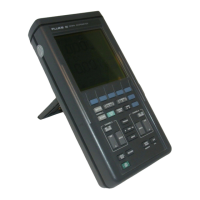7‘8
CORRECTIVE MAINTENANCE
MICROPROCESSOR 01201
3.
Measure
on
connector
contact X1
201
/6
to test the microprocessor D1201
.
Corrects 0.5 Hz.
Incorrect (defect microprocessor D1201
)
*•
not O.S Hz.
OPTICAL ItiXERPACE
4. Shine with a lamp In the
"Optical
interface
*
holes
to
test the optical interface receiver.
5.
Measure on the transceiver line D1 201/32.
Apply li^ht and verify that the signal level changes from OV DC (dark) to 0.3V DC (tight).
ADDRESS/DATA LINES
6. Measure
on address/data
t>u$ OO
(ADOO,
D1201/2J.
Correct
=
Logic 0.
All Other address data lines (AD01 to ADI
5)
are logic
1
(-i-SV).
7. Ground and release testpoint TP21
7
(first time) and the next address/data AD01 line will go low
(to logic
0).
Continue grounding and releasing testpoint TP2 17 until address/data line AD15 goes low
(fifteenth time).
With steps 6 and 7 the buffered addresses throughout the whole instrument are active and can
be
traced.
RAMS
D1204 AND D1206.
8. The next grounding of testpoint TP21
7
(sixteenth time) starts the RAM test of the
first
RAM
D1204. Measure on conr^ector contact XI 201/6.
During the RAM test connector contact starts at logic 0.
RAM correct
*
0.5 Hz,
HAM incorrect
=
logic 1
.
9. Grou n d and rel ease testpoint TP21
7
(seventeenth ti me) to start the RAM test of ^e secon d RAM
D1206. Measure on connector contact XI 201/6.
During the RAM test connector contact XI 201/6 starts at logic 0.
RAM correct
*
0.5 Hz.
RAM incorrect
s
logic 1
.
ESTABLISHING COMMUNICATION.
to. After the
seventeenth
time of
grounding TP217,
the
ScopeMeter sends an <XON> via the
RS-232 interface. Now communication is
established,
it is
possible
to
reprogram the
PI ashROMs. For special software contact your nearest Fluke/Ph^lipe Service
Center.
1 1 . Ground testpoint TP216 one more tme to abort the Kernel Test.

